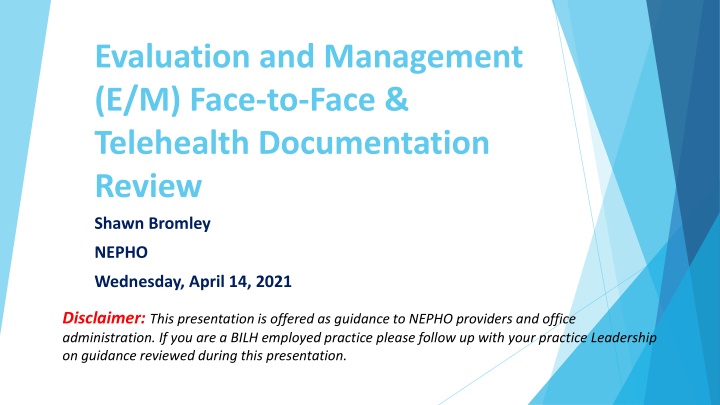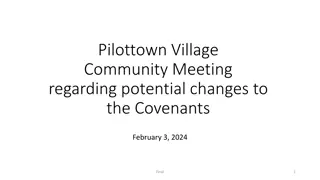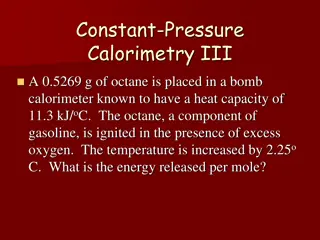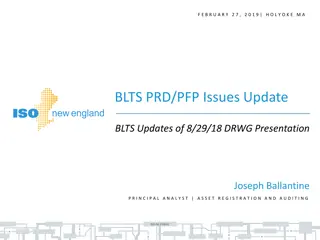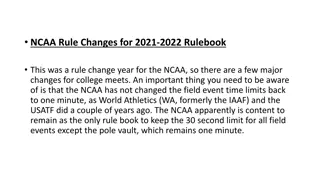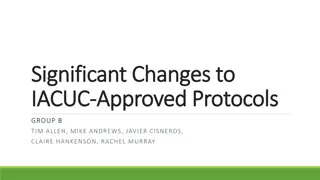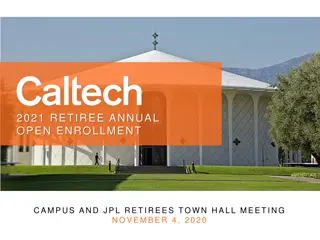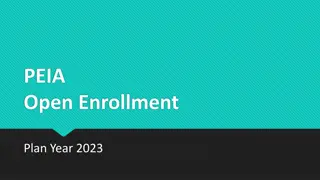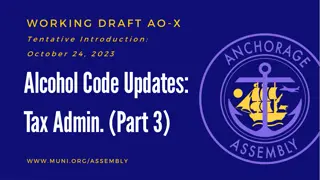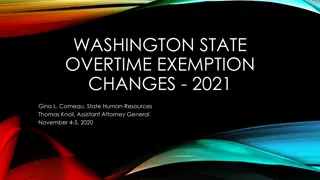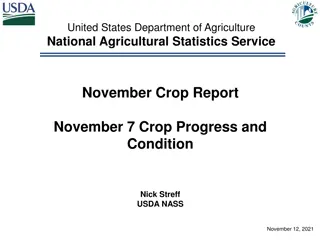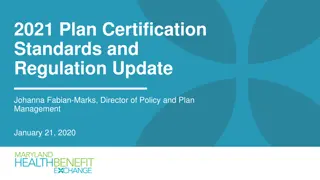E/M Documentation Changes in 2021
The E/M documentation for face-to-face and telehealth visits has been updated in 2021, focusing on medical decision-making and time spent on patient encounters. This presentation covers the key changes, leveling criteria, and examples of documentation based on time spent with patients.
Download Presentation

Please find below an Image/Link to download the presentation.
The content on the website is provided AS IS for your information and personal use only. It may not be sold, licensed, or shared on other websites without obtaining consent from the author.If you encounter any issues during the download, it is possible that the publisher has removed the file from their server.
You are allowed to download the files provided on this website for personal or commercial use, subject to the condition that they are used lawfully. All files are the property of their respective owners.
The content on the website is provided AS IS for your information and personal use only. It may not be sold, licensed, or shared on other websites without obtaining consent from the author.
E N D
Presentation Transcript
Evaluation and Management (E/M) Face-to-Face & Telehealth Documentation Review Shawn Bromley NEPHO Wednesday, April 14, 2021 Disclaimer:This presentation is offered as guidance to NEPHO providers and office administration. If you are a BILH employed practice please follow up with your practice Leadership on guidance reviewed during this presentation.
Agenda Evaluation and Management (E/M) Update Review Overview of 2021 Changes Leveling based off time Leveling based off Medical Decision Making (MDM) E/M billing during Annual Wellness Visit/Preventive Visit Telehealth Visit Requirements o Audio/Video Coding & Billing o Audio Only Coding & Billing o Additional Billing Opportunity o Telehealth Exam Documentation Review Resources
Overview of E/M 2021 Changes The extent of the history and physical exam will no longer affect the level of care. The level of care will be driven by medical decision-making OR by time. Time will include both face-to-face time and non-face-to-face time on the date of the visit. Pre-Visit Review Visit Encounter Post-Visit Planning There will be a new method for calculating medical decision-making (MDM). o New MDM Table Calculation The 99201 level of care will be deleted. 99211 will stay the same Nurse Visit/Low Level Established Patient There will be a new 99417 code for prolonged services for level 5 visit (99205 & 99215).
E/M Update Review Effective 1/1/2021 The requirement that 50% of the total time be spent providing counseling and/or coordination of care no longer applies in 2021. The following will now count toward the total time spent day of patient visit: preparing to see the patient (reviewing tests, etc.) obtaining and/or reviewing separately obtained history performing a medically appropriate exam and/or evaluation counseling and educating the patient/family/caregiver ordering medications, tests, or procedures referring and communicating with other health care professionals (when not separately reported) independently interpreting results (not separately reported) and communicating results to the patient/family/caregiver coordinating care (not separately reported)
Documentation Example Based Off Time Example: A 76-year-old established patient with mild to moderate dementia, who lives in an assisted living facility, presents with confusion related to her medication regimen. She also has diabetes and hypertension. Pill counts are performed during the visit and records from an urgent care center are reviewed. The physician also reviews medication pick-up history with the pharmacist. In addition to periodic urgent care visits with medication changes, the physician discovers erratic refill patterns. The physician has a phone call with the patient s family member who has power of attorney (POA) and helps with a pill planner. They discuss medication adjustments, and a plan to shift the patient s medication administration to supervised.
Time Calculation Tracking (Service Example) Time Tracking 2021 Leveling 2020 Leveling 18 minutes Pre-visit chart review, face-to-face encounter 15 minutes face-to- face encounter 6 minutes Review of urgent care records summary noted in EHR 11 minutes Discussion with pharmacy regarding medication adjustment 13 minutes Discussion with family member on medication adjustment 5 minutes Coordination with clinical staff on medication adjustment and timeframe Total 53 Minutes 99215: 40-54 minutes (total time spent pre-visit, face-to-face, post- visit) 99213: 15 minutes (face-to-face time only)
E/M Update Review Effective 1/1/2021 (continued) Using Medical Decision Making (MDM) the number and complexity of problem(s) that are addressed during the encounter the amount and/or complexity of data to be reviewed and analyzed, and the risk of complications, morbidity, and/or mortality of patient management decisions made at the visit associated with the patient s problem(s), the diagnostic procedure(s), and treatment(s). History and Exam are no longer a key component in determining visit level.
Documentation Example Based Off MDM Consider an established patient who has a follow up office visit for asthma management. The provider documents a medically appropriate history and exam and reviews an independent interpretation of a pulmonary function test (PFT). The provider makes a change to current medication and sends to the pharmacy. Using the 2020 scoring tool, providers would assign one point for the stable chronic condition, two points for the independent interpretation of the PFT test, and risk would be moderate. Overall, this would be a low complexity and the E/M level would score to a 99213.
2021 MDM Table Scoring Example Using the 2021 MDM table, the number and complexity of the problem addressed meets one stable chronic condition, which supports a low level risk. The provider reviewed and independently interpreted the PFT which falls under a moderate level for amount and/or complexity of data. Finally, the risk of complication is moderate due to prescription drug management. Since we have two elements that would be categorized as moderate, this would support the assignment of 99214. Moderate 99214 must meet 2 out of 3 Categories.
Face-to-Face Visits Versus Telehealth E/M Providers and patients who use telehealth are not always required to have a previously established relationship. Medicare will pay equally for telehealth and face-to-face visits. Providers often experience the increased demands of offering more services, while abiding by more policies and regulations.
E/M Billing During AWV In addition, if an insignificant issue or abnormality is discovered while performing the AWV and it does not require additional work, an E&M code should not be reported with the AWV code. If both codes are reported, make sure that the documentation supports both services and that there are no overlapping components. The following are some helpful tips regarding claim submission when reporting an AWV and E/M: List all chronic conditions. When using an E&M code (CPT codes 99201-99215) for a sick visit with the AWV, use the diagnosis code(s) that represents the problem or abnormality to match the additional documentation in the medical record. Remember to add modifier -25 to the E&M code.
E/M Billing During AWV (continued) Example: The patient comes in for AWV and it is discussed that they are experiencing severe abdominal pain after they workout. This has been happening for the last few months. The provider would code the subsequent AWV G0439 and will bill a 99213- 25. The provider is also going to refer the patient to a Gastroenterologist.
Telehealth Visit Requirements Audio/Video Coding & Billing Audio/Video evaluation and management visit: Office/outpatient E/M visit, new: 99202-99205: Office/outpatient E/M visit, established: 99212-99215 Chronic Care Management (CCM): Transitional Care Management (TCM): Attach the following to these codes as required to indicate this was a telehealth visit: o Modifier 95 Required by most commercial payers, use on an interim basis for Medicare telehealth billing* o Note: Medicare typically requires the Place of Service code 02 for telehealth services, however, practitioners billing Medicare telehealth services should use the same place of service code they typically use when billing for in-person services during the COVID-19 public health emergency.* POS 12 Home is also used for Telehealth services by some payers.
Telehealth Visit Requirements Audio Only Coding & Billing Telephone or audio-only evaluation and management services for new and established patients cannot originate from a related E/M service provided within the previous 7 days nor leading to an E/M service or procedure within the next 24 hours or soonest available appointment. o 99441: 5-10 minutes of medical discussion o 99442: 11-20 minutes o 99443: 21-30 minutes Digital E/M Services Online digital E/M services for established patient for a period of up to 7 days, cumulative time during the 7 days. These codes can be billed once a week and cannot be billed within a 7-day period of a separately reported E/M service, unless the patient is initiating an online inquiry for a new problem not addressed in the separately reported E/M visit. These services must be initiated by the patient (e.g., patient portal, e-mail). Medicare will cover these services for new patients during the public health emergency. o Physicians report: Qualified Non-Physician Professionals report: o 99421: 5-10 minutes 98970: 5-10 minutes o 99422: 11-20 minutes 98971: 11-20 minutes o 99423: 21 or more minutes 98972: 21 or more minutes
E/M Audio/Video or Audio Only Exam Elements Exam: Performing a physical exam via telehealth can seem challenging, especially if the patient is in their home where assessment tools, such as a blood pressure cuff or digital stethoscope, may not be available. But with some thoughtfulness providers are able to examine several organ systems. Telehealth Exam Documentation: o Eyes: Appearance of pupils (equal, round, extraocular eye movements) o Ears, Nose, Mouth & Throat: External appearance of the ears and nose (scars, lesions, masses) and assessment of hearing (able to hear, asks to repeat questions) o Neck : Gross movement (degrees of flexion anterior, posterior and laterally) o Respiratory: Audible wheezing, presence and nature of cough (frequent, occasional, wet, dry, coarse) o Cardiovascular: Presence and nature of edema in extremities o Constitutional: General appearance (ill/well appearing, (un) comfortable, fatigued, attentive, distracted, (disheveled) o Chest: Inspection of the breasts, chest tenderness o Abdominal: Tenderness on self palpation or area of pain o Musculoskeletal: Exam of gait and station (stands with/without use of arms to push off chair; steady gait, broad/narrowed based) o Skin: Rashes, lesions, ulcers, and cracking o Neurologic: Examination of sensation (by touch) o Psych: Orientation to time, place, and person, recent and remote memory, mood and affect, mood lability (crying, laughing)
Resources Shawn Bromley, NEPHO Director Contracting and Operations Lead Coding Initiatives shawn.m.bromley@lahey.org or 978- 236-1704 https://www.acog.org/practice-management/coding/coding- library/managing-patients-remotely-billing-for-digital-and- telehealth-services https://emuniversity.com/ https://caravanhealth.com/CaravanHealth/media/Resources- Page/Telehealth_PhysicalExam.pdf https://www.youtube.com/watch?v=4hRObfNyDvc
